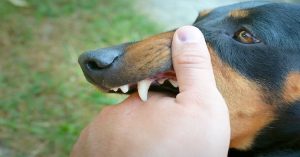For dog nails, use 60 to 80 grit sandpaper. This is suitable for grinding them down gently without causing harm.
Keeping your dog’s nails trimmed is crucial for their health and comfort. However, using regular nail clippers can be daunting for many pet owners. If you’re looking for an alternative method that’s less intimidating for both you and your furry friend, using grit sandpaper can be a great option.
By choosing the right grit sandpaper, you can effectively and safely grind down your dog’s nails without the risk of cutting them quickly. We’ll explore the benefits and techniques of using sandpaper for dog nail grooming and how to choose the appropriate grit to ensure a safe and comfortable experience for your pet.
Understanding Dog Nail Care
Proper nail care is essential to the overall well-being of your four-legged friend. As pet owners, it’s crucial to understand the importance of maintaining your dog’s nails at an optimal length to prevent health issues and ensure their comfort and mobility. In this section, we’ll delve into the significance of dog nail maintenance, signs of overgrown nails, and the risks associated with neglecting your dog’s nail health.
Importance Of Dog Nail Maintenance
Regularly trimming your dog’s nails is critical for their comfort and mobility. Overgrowth can lead to various health issues and discomfort, making keeping their nails at an appropriate length essential. Longer nails may cause pain, difficulty walking, and joint problems. Maintaining their nails at an appropriate length can help prevent these issues and ensure your pet’s overall well-being.
Signs Of Overgrown Dog Nails
It’s vital to recognize the signs of overgrown nails to address the issue promptly. Signs of overgrown dog nails include clicking sounds when walking, reluctance to walk on hard surfaces, visible curling of the nails, and discomfort when the paws are touched. Keeping an eye out for these signs enables you to take timely action and prevent potential complications related to overgrown nails.
Risks Of Ignoring Dog Nail Health
Neglecting your dog’s nail health can lead to serious risks and complications. Ignored nails may become ingrown, leading to infections and pain. Additionally, overgrown nails can alter your dog’s gait, causing pain and discomfort while walking. Regular grooming and maintaining optimal nail length are crucial to avoiding these risks and ensuring your pet’s well-being.
Sandpaper Grits Explained
In the world of dog nail grooming, sandpaper grits play a crucial role in achieving the desired results. Understanding the intricacies of different grits and their impact on dog nail health is essential for pet owners and professionals. Let’s delve into the details of sandpaper grits and their significance in maintaining your dog’s nail health.
Different Grits And Their Functions
When it comes to sanding your dog’s nails, the grit of the sandpaper plays a pivotal role. Grit refers to the coarseness or fineness of the sandpaper, which directly affects the abrasiveness and efficiency of the sanding process. The table below outlines the different grits and their corresponding functions:
| Grit | Function |
|---|---|
| Coarse (60-100) | Effective for trimming large and overgrown nails medium |
| m (120-180) | Ideal for shaping and smoothing nail edges |
| Fine (220-240) | Provides a polished finish and gentle smoothing |
Impact Of Grits On Dog Nail Health
The selection of grit during the nail sanding process can significantly impact your dog’s nail health. Using the wrong grit can lead to discomfort, pain, or even injury. It’s essential to understand the impact of grits on dog nail health to ensure a safe and effective grooming experience.
Choosing The Right Grit For Dog Nails
When it comes to choosing the right grit for your dog’s nails, it’s crucial to consider the condition and size of their nails. Additionally, understanding the impact of different grits on their nail health is essential for making an informed decision.
Best Practices For Sanding Dog Nails
When it comes to grooming your furry friend, maintaining their nail health is crucial for their comfort and overall well-being. Sanding dog nails using the right grit sandpaper is an effective yet gentle method to keep their nails trim and prevent painful overgrowth. In this blog post, we’ll discuss the best practices for sanding dog nails, including recommended sanding techniques, safety precautions, and tips for minimizing discomfort for your beloved pet.
Recommended Sanding Techniques
- Start by gently introducing your dog to the sanding tool to avoid causing anxiety or fear.
- Use a low-speed rotary tool with a sanding drum or a specialized pet nail sander for precise and controlled nail sanding.
- Hold the tool at a 45-degree angle and apply light pressure to gradually sand the tip of the nail.
- Regularly check the nail to avoid over-sanding and causing discomfort to your dog.
Safety Precautions For Sanding Dog Nails
- Ensure the sanding tool is in good working condition and the sandpaper is securely attached to prevent any accidents.
- Use protective goggles to shield your eyes from any nail shavings that may scatter during the sanding process.
- Avoid sanding the nail for extended periods to prevent overheating and discomfort for your dog.
- Keep the sanding tool away from your dog’s skin and fur to prevent accidental injuries.
Tips For Minimizing Discomfort For Dogs
- Offer treats and positive reinforcement to create a positive association with the nail sanding process.
- Take breaks between each nail to allow your dog to relax and reduce any potential stress or agitation.
- Monitor your dog’s body language and behavior for signs of distress, and stop sanding if they display discomfort.
- Ensure a comfortable and calm environment for the sanding session to help your dog feel relaxed and secure.
Assessing Various Dog Nail Types
Different Dog Nail Structures
When it comes to the type of grit sandpaper for dog nails, it’s important to consider the different structures of dog nails. Dogs’ nails vary in shape and size, and understanding these differences is crucial for determining the most appropriate sandpaper grit for trimming.
Individual Nail Considerations
Each dog’s nails are unique, and individual factors such as thickness, length, and sensitivity play a significant role in grit selection. By evaluating these specific characteristics, pet owners can tailor their sandpaper choice to meet their dog’s exact needs, ensuring a safe and effective nail-trimming process.
Implications For Sandpaper Grit Selection
Selecting the correct sandpaper grit for dog nails based on their structure and characteristics can have significant implications for the nail-trimming process. It not only ensures the comfort and safety of the dog but also contributes to achieving the desired nail length without causing discomfort or injury.
Factors Influencing Grit Selection
Determining the appropriate grit sandpaper for dog nails involves considering several factors. Dog breed and size, nail health and thickness variations, as well as behavioral tendencies all play significant roles in choosing the right grit for the task. Understanding these factors is essential for effectively and safely sanding your dog’s nails.
Dog Breed And Size Influences
Dog breed and size are crucial factors when selecting grit sandpaper for dog nail sanding. Large breeds with thick nails may require a coarser grit to effectively file down the nail, while smaller breeds with thinner nails may benefit from a finer grit. Additionally, dogs with longer quicks may need finer grit to avoid causing them any discomfort or injury.
Nail Health And Thickness Variations
Nail health and thickness variations should be carefully assessed before choosing the grit sandpaper. If your dog has brittle or overgrown nails, you may need a coarser grit to trim and shape them effectively. Conversely, if your dog has healthy, thin nails, a finer grit will suffice for keeping them at an appropriate length.
Behavioral Considerations For Grit Selection
Understanding your dog’s behavioral tendencies is essential in determining the right grit for the sandpaper. Dogs that are sensitive about their paws may benefit from a finer grit to minimize discomfort during the sanding process. Conversely, dogs that are comfortable with nail maintenance may tolerate coarser grits for quicker results.
How To Safely Sand Your Dog’s Nails
Sanding your dog’s nails can be a nerve-wracking process, but with the right tools and techniques, it can be done safely and effectively. In this guide, we will walk you through the step-by-step sanding process, the tools you’ll need for safe sanding, and how to practice patience and care during the process. With a little patience and the right approach, you can keep your furry friend’s nails trimmed and healthy.
Step-by-step Sanding Process
When it comes to sanding your dog’s nails, it’s important to take it slow and be gentle. Here’s a step-by-step process to safely sand your dog’s nails:
- Start by getting your dog comfortable and relaxed. This might involve giving them treats or petting them to ease any anxiety.
- Identify the quick, which is the sensitive part of the nail that contains blood vessels and nerves. You’ll want to avoid sanding this area to prevent pain and bleeding.
- With the appropriate grit sandpaper, gently begin sanding the tip of the nail, avoiding the quick.
- Continue sanding in small increments, frequently checking the nail’s progress to avoid over-sanding.
- Finish by smoothing the edges of the nail and giving your dog plenty of praise and rewards for their cooperation.
Tools For Safe And Effective Sanding
Having the right tools is essential for safe and effective nail sanding. Here are the tools you’ll need:
- Grit sandpaper suitable for dog nails, typically around 80-120 grit for most dogs.
- A pet-friendly nail grinder or Dremel tool for more precise sanding and smoothing.
- Treats or rewards to keep your dog calm and cooperative during the process.
- Styptic powder or cornstarch to stop bleeding in case the quick is accidentally nicked.
Practicing Patience And Care During Sanding
It’s crucial to approach sanding your dog’s nails with patience and care. Here are a few tips to help make the process smoother:
- Stay calm and reassure your dog throughout the sanding process to keep them relaxed.
- Avoid rushing and take breaks as needed to prevent stress for both you and your dog.
- Pay close attention to your dog’s body language and be mindful of any signs of discomfort or distress.
- Never force your dog to continue if they become too anxious or agitated. It’s important to prioritize their well-being over completing the sanding process in one go.
Professional Vs. Diy Sanding: Pros And Cons
When it comes to sanding your dog’s nails, you may wonder if you should go the professional route or tackle the task yourself. Understanding the pros and cons of professional versus DIY sanding can help you make an informed decision that suits your dog’s needs and preferences. Let’s delve into the considerations.
Cost And Time Considerations
When opting for professional nail sanding, the cost can vary based on the location and the specific service provider. Generally, you can expect to pay anywhere from $10 to $30 for this service. On the other hand, DIY sanding requires an upfront investment in the necessary tools, such as a high-quality grit sandpaper or a rotary grinder, costing approximately $20 to $40. As for time, professional sessions can be quicker, usually taking about 10-15 minutes, whereas DIY sanding may take longer, requiring more time for the grooming process.
Safety And Expertise Factors
Professional sanding ensures that your dog’s nails are handled by experienced groomers who possess the expertise to trim and shape the nails safely. This reduces the risk of causing discomfort or injury to your pet. However, with DIY sanding, the safety aspect relies on your level of expertise and confidence in using the tools. If not executed carefully, there’s a potential for over-trimming or causing pain to your dog.
Making An Informed Decision
Ultimately, the decision between professional and DIY sanding should be based on your dog’s comfort, your budget, and your level of confidence in handling the task. While professional services offer convenience and expertise, they come with a recurring cost. DIY sanding, although cost-effective in the long run, requires time and a learning curve to ensure safety and precision. Considering these factors, you can make an informed decision that suits you and your furry friend.
Maintenance And Monitoring
When it comes to maintaining and monitoring your dog’s nail health, using the right grit sandpaper is crucial. Regular maintenance and monitoring can help ensure the overall health and well-being of your pet. Proper post-sanding nail care tips, regular nail health check-ups, and ensuring continued nail health are essential to focus on.
Post-sanding Nail Care Tips
After sanding your dog’s nails, it’s important to follow proper post-sanding nail care tips to prevent any discomfort or potential issues. Make sure to inspect the nails for any signs of irritation or uneven surfaces. Additionally, apply a soothing balm or moisturizer to keep the nails and surrounding skin hydrated. This can help prevent any dryness or potential cracking.
Regular Nail Health Check-ups
Scheduling regular nail health check-ups with your veterinarian is essential for monitoring the condition of your dog’s nails. During these check-ups, your vet can assess the length, shape, and overall health of the nails, ensuring they are properly maintained. Regular check-ups can help avoid overgrowth, reduce the risk of nail-related injuries, and address any potential underlying health issues.
Ensuring Continued Nail Health
Ensuring continued nail health involves consistent monitoring and maintenance. This includes regular trimming or sanding, providing a balanced diet rich in essential nutrients for nail strength, and promoting overall physical activity to wear down the nails naturally. Additionally, providing appropriate surfaces for scratching and maintaining proper foot hygiene can contribute to continued nail health and overall well-being.
Frequently Asked Questions
What Grit Sandpaper Is Suitable For Trimming Dog Nails?
Using 120-grit sandpaper is ideal for trimming dog nails as it provides a balance between effectiveness and safety.
Why Should I Use Grit Sandpaper For Dog Nails Instead Of Clippers?
Grit sandpaper offers more precision, reduces the risk of cutting the quick, and provides a smoother finish for your dog’s nails.
Can I Use Any Grit Sandpaper To Trim My Dog’s Nails?
It’s recommended to use fine-grit sandpaper specifically designed for pet nail grooming for the safety and comfort of your dog.
How Do I Safely Use Grit Sandpaper For Trimming My Dog’s Nails?
Start by gently filing the tip of the nail at a 45-degree angle, then gradually smoothen the edges to maintain a comfortable length for your dog.
What Are The Benefits Of Using Grit Sandpaper For Dog Nail Trimming?
Grit sandpaper allows for gradual smoothing, reduces the likelihood of splintering nails, and provides a stress-free and gentle comfort for your pet.
Are There Any Risks Of Using Grit Sandpaper On Dog Nails?
When used properly, grit sandpaper is safe and effective. However, it’s important to avoid excessive filing to prevent over-trimming.
How Often Should I Trim My Dog’s Nails Using Grit Sandpaper?
It’s advisable to trim your dog’s nails every 1-2 weeks, or as needed, to maintain a comfortable and healthy nail length.
Are There Any Precautions I Should Take When Using Grit Sandpaper For My Dog’s Nails?
Ensure your dog is comfortable and relaxed, file in well-lit areas, and stop if you notice any signs of discomfort or bleeding.
Conclusion
Choosing the right grit sandpaper for dog nails is crucial for their safety and comfort. By understanding the specific grit levels and their suitability for different nail types, you can effectively groom your dog’s nails at home. Always prioritize your dog’s well-being and consult with a professional if you’re unsure.
Happy sanding!
Related posts:
 How Much Does Petco Charge for Nail Trim | Budget-Friendly Pricing Revealed
How Much Does Petco Charge for Nail Trim | Budget-Friendly Pricing Revealed
 How to Find the Quick on Black Dog Nails? Proven Tips for Safe Trimming
How to Find the Quick on Black Dog Nails? Proven Tips for Safe Trimming
 What is the Easiest Way to Trim Dog Nails ? Hassle-Free Techniques for Grooming
What is the Easiest Way to Trim Dog Nails ? Hassle-Free Techniques for Grooming
 How Often to Clip Dog Nails ? Essential Tips for Nail Care
How Often to Clip Dog Nails ? Essential Tips for Nail Care
 How Short Should Dog Nails ? Complete Guide to Optimal Length
How Short Should Dog Nails ? Complete Guide to Optimal Length
 Why is My Dog Biting His Nails? Uncovering the Root Cause
Why is My Dog Biting His Nails? Uncovering the Root Cause

